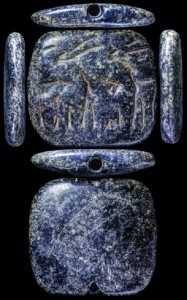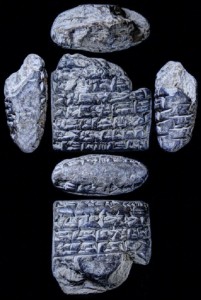Babylonian Clay Tablets
Published in Artefacts, Issue 5 (September/October 2015), Volume 23
Pre-writing stamp seal (front, back and edges of the tablet) of an antelope, the oldest in the collection. (Cuneiform Digital Library Initiative)
Thousands of years before global giants like Apple and Amazon introduced them to the mass market as a technological breakthrough, the humble tablet was already being used in ancient Mesopotamia. The process of marking or inscribing clay tablets with characters, constituting an early form of writing, dates back to the fourth millennium BC. Several Irish institutions, such as the Chester Beatty Library and the National Museum, hold extraordinary examples of these tablets. One of the largest collections of cuneiform tablets in Ireland is housed in the Russell Library, Maynooth University, which contains the historical collections of St Patrick’s College, Maynooth.
The collection of 65 cuneiform tablets in the Sumerian language and a pre-writing stamp seal were collected by an Irish army chaplain during the First World War. The material dates from c. 3500–1900 BC and includes both cuneiform tablets and cones bearing royal inscriptions from the early Babylonian period, as well as administrative and economic accounts from the Ur III period (c. 2100–2000 BC). Perhaps the highlight of the collection is a gable-shaped stone seal from the pre-writing period, possibly originating from Anatolia (modern Turkey) or northern Syria, which depicts three antelopes and was presumably used as a security seal for trading goods.
A group of tablets and cones contain an inscription relating to Sîn-kāšid, a king of the ancient Mesopotamian city of Uruk nearly 4,000 years ago during the early Babylonian period. This ruler built the temple of Eanna (literally, the ‘House of Heaven’) and commissioned tablets and cones with inscriptions bearing witness to this deed:
‘Sîn-kāšid, mighty king, king of Uruk, king of Amnānum, provider of the House of Heaven, his palace of kingship he built’.

Administrative text from the Ur III period. (Cuneiform Digital Library Initiative)
The success of this propaganda campaign can be measured in the survival of many of these artefacts, which are scattered throughout the world in various museums and libraries. The Russell Library holds sixteen wonderfully preserved cones and tablets bearing this particular inscription.
Other texts in the collection offer a fascinating insight into everyday life in Babylonia during the late third millennium BC and relate to trade and agriculture. These texts bear witness to the rather complex administration of the Ur III state, which dealt, among other things, with the incoming and outgoing of goods and the assignment of workers to specific tasks. This exciting collection has recently been digitised and is now freely available on the website of the Cuneiform Digital Library Initiative, http://cdli.ucla.edu/, a joint project of the University of California, Los Angeles, the University of Oxford and the Max Planck Institute for the History of Science, Berlin.
The collection is on display at the Russell Library, Maynooth University, and can be viewed during normal opening hours (Monday, Wednesday and Thursday, 10am–1pm and 2pm–5pm).
Barbara McCormack is a Special Collections Librarian at Maynooth University; Klaus Wagensonner is a researcher on the Cuneiform Digital Library Initiative at the University of Oxford.
















